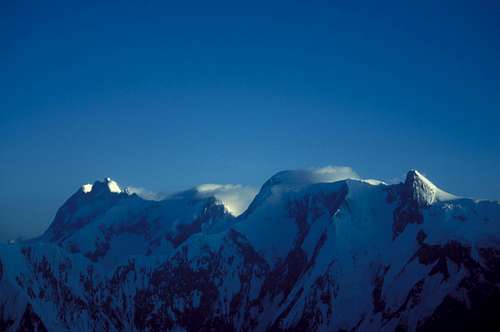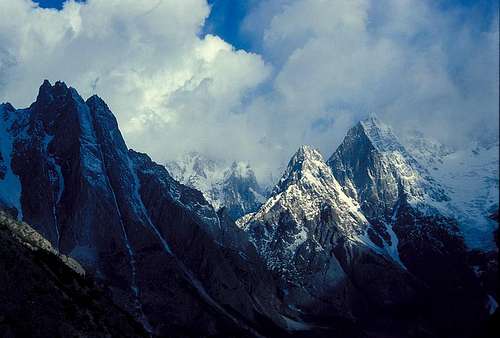-
 24732 Hits
24732 Hits
-
 93.58% Score
93.58% Score
-
 43 Votes
43 Votes
|
|
Mountain/Rock |
|---|---|
|
|
36.51029°N / 74.52276°E |
|
|
Mountaineering |
|
|
Summer |
|
|
25574 ft / 7795 m |
|
|
Overview
Batura I is the highest mountain in the Batura Muztagh, the westernmost sub-range of the Karakoram. The Hunza Valley forms the eastern boundary of the range which extends west as far as the Hindu Kush and Hindu Raj. The range is relatively accessible as the Karakoram Highway runs up the Hunza Valley. Some of the highest peaks in the Karakoram outside of the Baltoro region are found here and the 56km long Batura Glacier is the fourth longest in the Karakoram.
An Anglo-German expedition was the first to attempt Batura I from the Batura Valley in 1959, when five climbers died high on the northern slopes of the mountain. All subsequent attempts were from the south. The summit was first reached by Germans Hubert Bleicher and Herbert Oberhofer in 1976, climbing the south face from the Baltar Valley. An Austrian expedition summited in 1983, climbing from the Muchuhar Valley to join the south face route. The Muchuhar route was climbed by a Polish-German expedition in 1988. An international team made the first alpine-style ascent of Batura in 1996 by the Muchuhar route. Finally, three Japanese climbers died in an avalanche high on the Muchuhar route in 1999.

The Batura Crest from Bojohagur Duanasir with (right to left) Passu Sar, the unclimbed Muchu Chhish and the Batura peaks.
Batura consists of six separate summits according to mapmaker Jerzy Wala (see route photo and caption) or four summits according to Wikipedia. These summits form a crest known as the Batura Wall. In its entirety this crest extends over 35km without dropping below 6100m. Some of the peaks along the crest are as follows:
At the eastern end, Ultar Sar (7388m) is right above the Karakoram Highway. Fifteen expeditions attempted this steep mountain before it was finally climbed in 1996. Also visible from the highway is the elegant Shispare (7610m) which has only had one ascent, in 1975. Further west, Muchu Chhish (7453m) is one of the highest unclimbed peaks in the Karakoram. Of the Batura summits, Batura II (7762m) was the last to be climbed in 2008 after repeated attempts.
Other significant peaks in the range are the spectacular spire of Hachindar Chhish (7163m), climbed only once in 1982 and the unclimbed Kuk Sar II (6943m), whose north face is one of the most impressive in the Karakoram.
Getting There
The nearest international airport is Islamabad. PIA flies daily from Islamabad to Gilgit, the biggest town in the Northern Areas. The flights are sometimes cancelled at short notice due to bad weather.Gilgit can also be reached by bus along the Karakoram Highway from Pir Wadhai bus station in Rawalpindi. Buses leave in the afternoon and arrive around mid morning the next day, but can be delayed if the road is washed out or blocked by landslides, particularly during the monsoon rains in July and August. See www.lonelyplanet.com/thorntree for a travel forum and the latest on travel on the Karakoram Highway.
From Gilgit get a Hiace van up the Karakoram Highway to Aliabad (3 hours drive) in the Hunza Valley. Aliabad is the closest village to the start of the trek up the Muchuhar Valley to Base Camp. Otherwise, get a Hiace van to nearby Karimabad which is a pleasant place to stay.
Trekking to Base Camp
Porters can be hired in Aliabad. Pay will be per stage. On trekking routes there are established stages representing a day's walk, although sometimes more than one stage is walked in a day. Stages tend to be based on the best places to camp. Rates per stage are governed by the Ministry of Tourism, but will vary according to local conditions.
The trek to into the Muchuhar Valley starts at Hassanabad, a few kilometers from Aliabad. There is a good track as far as the snout of the Hassanabad Glacier. Climb onto the glacier and cross to the west side. Follow the edge of the glacier, then the rubble-strewn glacier itself which becomes the Muchuhar Glacier. The trail is intermittent as far as the last pastures beside the glacier, then non-existent. Base camp is at Oyarmin, right below the south face of Batura. The trek is strenuous and takes 3-4 days.
The trek to the north side of Batura is well travelled and rather easier. Porters can be hired in Passu. A boat must be taken along Attabad Lake if approaching Passu from the south. From Passu follow ablation valleys along the northern edge of the Batura Blacier. Pass the summer settlement of Yashpirt and reach the yak grazing pastures at Lupdhor after 3-4 days, with great views of the Batura Wall along the way.
Hunza Landslide
Red Tape
Now is a very good time to climb in Pakistan in terms of peak fees which have been considerably reduced in recent years. Peaks up to 6500m require no permit (previously 6000m). Peak fees in the Baltoro region have been reduced to 50%. In an effort to encourage people to climb outside the Baltoro region, peak fees in the Gigit region (i.e. Batura I) have been reduced to 10%.
The previous fee for peaks between 7501m and 8000m (i.e. Batura) was $4000 for a party of up to seven people with an additional royalty of $500 dollars for each person above seven.
Now, in 2017, the fee for Batura is a very reasonable $400 for up to seven people, and $50 for each additional person.
Also in the Gilgit region a liaison officer is no longer required. An agent is still required (for expeditions requiring a permit) and the guide they provide can fulfill the role of the liaison officer.
Procedures as organized by your agent will involve a briefing at the Ministry of Tourism in Islamabad before and after the expedition. Not all expedition members are required to attend the briefings, so it is possible to remain in the mountains after the expedition has ended. Usually a returnable helicopter bond must be deposited before the expedition.
For expeditions to peaks below 6500m you can do it all yourself. Just turn up at the last village and start haggling over porters!
Good agents I have used are:
- Adventure Tours Pakistan
- Himalaya Trek and Tours
Camping
There are some wonderful grassy and wooded campsites on the ablation valleys beside the Muchuhar Glacier, but they are high above the glacier and off the trekking route. The Base Camp at Oyarmin is on a grassy ablation valley with a good stream. There are nice campsites on the ablation valleys along the Batura Valley, particularly at Lupdhor.
Camping Fuel
Kerosene is available in Gilgit and other towns but it burns very sooty so be prepared to clean your stove. White gas is not available. Gas canisters left by previous expeditions are available in Gilgit. Canisters are said to be refilled, but they have always worked for me. Otherwise canisters will need to be freighted from abroad or bought from your agent.
Expedition Food
A good selection of food is available in Islamabad, Gilgit or Karimabad. The only food you might consider bringing with you is special mountain food.
Accomodation
This is cheap in Pakistan. In Gilgit the New Madina Guesthouse is recommended. Karimabad is a good place to relax after climbing. The cheap guesthouses around Zero Point are a good place to stay. I like the Haider Inn.
The Route

Batura south face route from the Muchuhar Valley. Only the top half of the route is visible, coming in from the Batokshi Col at 6000m on the left of the picture. Batura I's summit is centre. The unclimbed Batura I West (7794m) is left of centre. The pointed summit to the left is Batura II. Batura V is on the right and Batura VI is on the right edge of the picture.
The south face route from the Muchuhar Valley has a considerable height gain due to the low altitude of base camp at 4000m. Climb snow slopes, steepening towards the Batokshi Col at 6000m. The route from the Baltar Valley joins the Muchuhar route at this point. Make a rising traverse rightwards across snow slopes and ice fields to join the south ridge. Climb the left side of the ridge and join the east ridge just before the summit. Camp sites will vary.
When to Climb
Research
Batura Mustagh Orographical Sketch Map 1:100,000 by Jerzy Wala.
An excellent and accurate map which also includes topo-diagrams of some routes on the higher peaks.
Swiss Foundation for Alpine Research Karakoram 1:250,000 Orographical Sketch Map. Sheet 1 shows Batura.
Popular and useful maps which are generally accurate.
Books
Chronik der Erschließung des Karakorum by Wolfgang Heichel. Teil I – Western Karakorum. Wissenschaftliche Alpenvereinshefte, Heft 36. Gemeinsam herausgeben vom Deutschen und vom Österreichischen Alpenverein. München 2003.
This is the first volume of what is intended to be an exhaustive chronicle of the climbing history of the Karakoram range. It contains stacks of useful information and excellent maps by Jerzy Wala. Volume I covers the mountains west of the Hunza River including the Batura Muztagh. Volume II is intended to cover the Rakaposhi Range and Volume III the Hispar Range. Only available in German.
Karakoram: Mountains of Pakistan by Shiro Shirahata (1998) ISBN: 093856725X
Stunning photos including Batura.
High Asia: An Illustrated History of the 7,000m Peaks by Jill Neate (1989) ISBN: 0898862388
Useful reference book.
Websites
www.climbmagazine.com for Mountain Info, a record of world mountaineering.
www.americanalpineclub.org for easily searchable online American Alpine Journal expedition reports.
www.alpineclub.org.uk for the Himalayan Index, a useful starting point to determine what has been climbed on peaks 6000m and above.
http://blankonthemap.free.fr/default.htm is a website in French and English devoted to the mountains of Northern Kashmir i.e. the Karakoram, Nanga Parbat, Hindu Kush and Hindu Raj.




